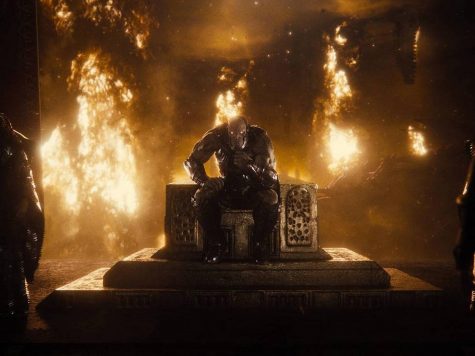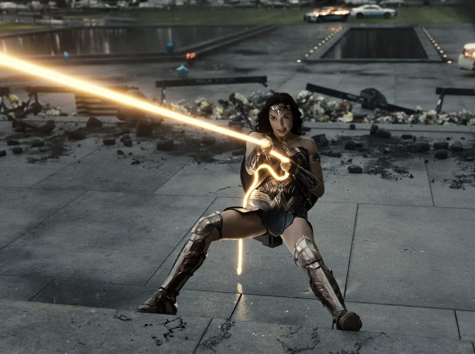Snyder’s ‘Justice League’ is a monumental superhero film fueled by passion
Released exclusively to HBO Max on March 18th, 2021, and boasting a 4 hr and 2 minute runtime, Zack Snyder’s extended cut of Justice League has become one of the most anticipated comic book films of the past year. This anticipation comes from a passionately strong fanbase and a riddled history marked by the studio dynamics of Hollywood. When Warner Brothers announced their slate of DC Universe films set to release throughout the latter half of the 2010s, this announcement was met with excitement from fans, as well as skepticism that stemmed from the question of how Warner Bros could compete with the cohesive and strategic storytelling formula established by Marvel Studios.
Among the slate of the films, was “Justice League,” which could easily make or break the potential for a DC Cinematic Universe. “Justice League” became an even bigger for Warner Bros after the critical and commercial failure of both “Batman V Superman: Dawn of Justice” and “Suicide Squad” in 2016.
The success of the film became more unpredictable when it was announced months prior to release that Zack Snyder would be stepping away from the film momentarily to grieve over a family tragedy, with Avengers director Joss Whedon stepping in to finish production. Upon release, the film received negative reception for its poor imitation of the MCU formula, distracting continuity errors due to reshoots, and a forcibly bright tone that contrasts with the darker tone of “Batman V Superman.” The issues in the theatrical cut of the film stem from the clash of directing styles between Snyder and Whedon, and the highly-publicized tampering from studio executives.

Soon after the theatrical cut’s release, fans began to petition and demand for a release of Snyder’s original cut of the film. In the midst of circulating rumors, Snyder confirmed its existence in 2019 and revealed that its release was up to Warner Bros to decide. A year later, it was announced that Warner Bros would be releasing the film on HBO Max in 2021 and that Snyder would receive additional funding to complete the film as he saw fit. Released on March 18th, 2021 “Zack Snyder’s Justice League” was made available to HBO Max subscribers.
Snyder’s ability to complete the film and present it in his own creative vision is an opportunity that most filmmakers can only dream of. Fueled by the support of fans, “Zack Snyder’s Justice League” is a strong improvement over the theatrical cut that provides fans with an exciting take on the DC Mythos and a stronger connection to the film’s heroes.
Taking place after the death of Superman (Henry Cavill) in “Batman V Superman,” the film follows the efforts of Batman (Ben Affleck), Wonder Woman (Gal Gadot), Aquaman (Jason Momoa), Cyborg (Ray Fisher) and The Flash (Ezra Miller) as they race against time to defeat Steppenwolf (Ciarán Hinds), an alien military commander in search of artifacts to destroy Earth. While the film carries the same premise as the theatrical cut, it expands more upon the characters, events, and features a greater level of violence.Alongside these extended aspects come new added scenes that were filmed in 2020 upon the announcement of the new cut. Some new additions to the cast include Darkseid (Ray Porter), Martian Manhunter (Harry Lennix), and the return of the Joker (Jared Leto).
In its four hour runtime, the film tells an expansive story that delves into the lore of the DC Universe and makes it easier for audiences to connect with the main team of characters. The plot itself is quite basic and predictable as one can expect from popcorn Blockbusters or any of Snyder’s other films, though the true strength of the story is in its characters. Whedon’s take on the film tried to make the team into MCU-esque archetypes through ludicrous and unnatural comedic timing, Snyder’s film reinforces the role of each member as being god-like figures among mankind who are defined by their backgrounds and capable of extraordinary feats.
For instance, Flash and Cyborg, characters that fans would say Whedon underutilized, are used to their fullest potential in the new film as they receive their own character-defining moments and their abilities factor well into several climatic events. The film is very character-centric, even Steppenwolf is given a complex background that gauges a surprising amount of sympathy and works much better as opposed to the less detailed and one-dimensional nature the character was given in the former release. As the untime can be daunting for some, the film includes an episodic chapter structure that can allow viewers to take breaks wherever they see fit.
The energy of the film’s characters comes from the extensive ensemble cast, as well as their chemistry with one another. While Ben Affleck’s previous outing as Batman was a far cry from the dark and brutal introduction he’d been given initially, the Snyder Cut returns to that depiction and gives Affleck the chance to portray him as an intelligent leader, and become closer to the version of the character seen in comics.

Gal Gadot’s Wonder Woman is a strong effective contrast from how she was portrayed in her solo films as the film portrays her as more of a hardened warrior rather than the traditionally bright and flashy superhero. While the cut introduces intriguing possibilities for Superman, it still feels like Cavill isn’t given much screen time to display emotional range in the role.
Momoa, Fisher and Miller are also given more to do with the re-introduction of their characters as they’re each able to add much more nuance within the new footage that highlights them. Fisher’s Cyborg carries the emotional weight of the film as the reluctant hero of sorts, which allows him to display a wide range of emotions and deliver a memorable portrayal of the character. Nearly every character feels redeemed from misrepresentations or the lack of depth seen in previous DC films, especially Jared Leto’s Joker.
Disregarding the lack of complexity in Snyder’s storytelling, one can’t deny his flair for stylistic visuals and production design. The film boasts a cold color palette that fits well in relation to the film’s darker themes of world destruction. Every environment or set piece on screen feels like it could’ve easily been lifted from a comic book panel as they feature a tremendous amount of detail and feel connected to the world of DC.
Snyder’s trademark slow motion shots are included excessively but feel fitting, as they serve the purpose of capturing the superhuman characters performing otherworldly feats that demonstrate visual mastery and brilliance. Also, the newly-implemented 4:3 aspect ratio further lends to the impression of a comic book panel and places emphasis on the film’s cinematic scope.
While some of the song choices also feel out-of-place or overused, the musical score from Junkie XL emphasizes the sense of action, energy and innovation that was missing from Danny Elfman’s original score. As a whole, the aesthetic choices work together in service to Snyder’s definitive vision.
Zack Snyder’s Justice League stands out as one of the best films to come out of the DC Extended Universe’s (DCEU) lineup thus far. Being a passion project for Snyder, it’s easily his most ambitious and highly-praised film so far. The future for Snyder’s Justice League series looks grim as he’s confirmed there will be no sequel; however, that could change, given the film’s positive reception from HBO Max subscribers. Regardless of its place in the DC Canon, “Zack Snyder’s Justice League” is a terrific superhero film that demonstrates both the large-than-life style of the DC Universe and the powerful impactful a director can have on a film.








